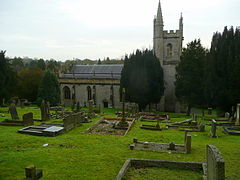Pilton, Somerset
| Pilton | |
|---|---|
 Church of St John the Baptist, Pilton |
|
| Pilton shown within Somerset | |
| Population | 998 (2011) |
| OS grid reference | ST595405 |
| District | |
| Shire county | |
| Region | |
| Country | England |
| Sovereign state | United Kingdom |
| Post town | SHEPTON MALLET |
| Postcode district | BA4 4 |
| Dialling code | 01749 |
| Police | Avon and Somerset |
| Fire | Devon and Somerset |
| Ambulance | South Western |
| EU Parliament | South West England |
| UK Parliament | |
Pilton is a village and civil parish in Somerset, England, situated on the A361 road in the Mendip district, 3 miles (5 km) south-west of Shepton Mallet and 6 miles (10 km) east of Glastonbury. The village has a population of 998. The parish includes the hamlets of West Compton, East Compton, Westholme, Beardly Batch and Cannards Grave.
Pilton is now almost 20 miles (30 km) from the sea but sits on the edge of the Somerset Levels, an area which has now been drained but was once a shallow tidal lake. According to legend in the 1st century, being a landing place then known as Pooltown, it is where Joseph of Arimathea landed in Britain .
The parish of Pilton was part of the Whitstone Hundred.
Cannard's Grave is located on the southern edge of Shepton Mallet. Local legend (of which there are several versions) says that, in the 17th century, the publican of the local inn, Giles Cannard (possibly also known as Tom the Taverner), engaged in criminal activity such as robbing, or aiding and abetting the robbery of, his guests, theft, smuggling and possibly forgery. His activities having been discovered, he either committed suicide or was convicted and hanged from the gibbet at the adjacent crossroads and buried nearby. Other explanations of the name include a tale that Kenred a pagan and uncle of King Ine who converted to Christianity was buried there. Perhaps the most likely story is that a thief convicted of sheep stealing was tried and hanged at the site.
...
Wikipedia

